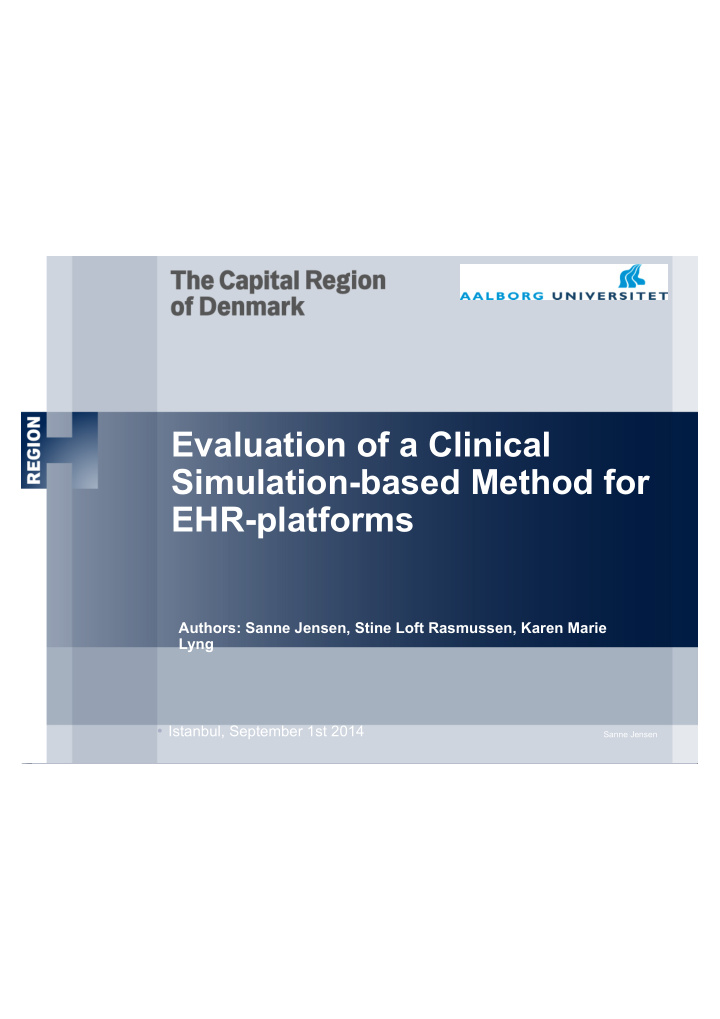



Evaluation of a Clinical Simulation-based Method for EHR-platforms Authors: Sanne Jensen, Stine Loft Rasmussen, Karen Marie Lyng • Istanbul, September 1st 2014 Sanne Jensen
Background • Procurement of new EHR-platform 2012 – 2013 • 2 Danish regions covering half the Danish population • 20 hospitals with approx. 40,000 healthcare professionals • Broad functionality to support clinical and administrative core processes • Strategic demand of simulation-based assessment: • shall cover usability & human factor issues • must cover demands from various different end-users, specialties and cultures • shall meet transparency demands of procurement in a public tender according to EU rules
Purpose of new EHR-platform Main topic is increased effectiveness in quality of care 1. continuity of care and patient safety 2. streamlining of clinical processes and workflow 3. patient and employee satisfaction Furthermore • Support cross-functional work processes • Support hand-over of responsibility
Clinical simulation • Clinicians using it-systems in realistic environments • Clinical simulation may be used for various purposes and in all stages of the lifecycle of clinical information systems
Challenges to qualitative approach Methodological requirements: • Comparable assessment results • Uniformly assessment of the EHR-platforms • Transparent process • Easily collected and rapidly analyzed results Size of procurement: • All aspects of EHR-platform should be covered • Many clinical specialties and professionals • All types of users should be considered
Overview of assessment Green team 1. 1st visit in outpatient department Overall metrics for 1. Broken hip • 3 physicians Data collection: 2. Interruption and shift between assessment • surgery, internal medicine , psychiatry 2. Appendicitis patients 1. support of key areas • 3 nurses Observations and 3. Depression 3. Assignment to hospital (physician) • surgery, internal medicine , psychiatry 2. user experience of systems questionnaires 4. Chronicle Obstructive Red team 4. Initial nursing assessment 3. patient safety • 3 physicians 5. Pulmonary Disease Patient care • Patient safety • surgery, internal medicine , psychiatry Specific parts of daily work 6. Discharge from hospital (COLD) • Ease of use • 2 nurses practice, that will be (physician) 5. Breast cancer • surgery, internal medicine assessed: • Usefulness 7. Shift of rounds (nurses) • 1 medical secretary 6. Child with failure to 4. documentation Blue team 8. Medical supervision thrive 5. overview (patient- • 3 physicians 9. Ward shift Questions related to information and tasks) • surgery, internal medicine , pediatric 10. Discharge from hospital (nurse) • 2 nurses 6. plans specific tasks and 11. Dispensation & administration of • surgery, internal medicine 7. decision support scenarios drugs • 1 medical secretary 12. Outpatient control Navn (Sidehoved/fod)
Detailed plan
Evaluation of assessment method • Purpose: • What is the eligibility of the method? • What are the advantages/disadvantages? • Reveal possible issues to be improved • Method: • Observations • Semi-structured interviews Titel/beskrivelse (Sidehoved/fod) Navn (Sidehoved/fod)
Result: assessment of user satisfaction Pros • User involvement • Subjective evaluation is easily done • Possible to reflect on and assess each of the platforms and differences Cons • Objective assessment is difficult • Difficult to assess minor variances in ease of use • Interruptions influenced fidelity and realism Titel/beskrivelse (Sidehoved/fod) Navn (Sidehoved/fod)
Result – assessment of usefulness Pros • Efficient method to examine vendors descriptions • Deep insight in the EHR-platform was gained • Assessment across specialties and healthcare groups • Differences in clinical needs became obvious • Broad insight due to structural training Cons • Not part of the assessment • System integrations • Longitudinal time factor Navn (Sidehoved/fod)
Result – assessment of patient safety Pros • Clinical simulation can reveal patient safety issues not evident in textual descriptions • Detailed use of technology is visualized by clinical simulation Cons • Patient safety experts should have observed the simulations Titel/beskrivelse (Sidehoved/fod) Navn (Sidehoved/fod)
Result – general issues Pros • Use of ”patients” supported realism in scenarios a facilitated a smooth flow in the simulation • Vendors found they were treated equally and fair Cons • Lack of complexity in patient cases • Fewer patients than in every-day work • Vendors would have preferred to use their own test data Titel/beskrivelse (Sidehoved/fod) Navn (Sidehoved/fod)
Discussion • Assessment of qualitative aspects were possible • Metrics of assessments must be very specific • Users get first-hand experience • Support of work practice were assessed • Difficult balance between transparency and clinical relevance • A lot of training is needed • Resource demanding Titel/beskrivelse (Sidehoved/fod) Navn (Sidehoved/fod)
Conclusion Clinical simulation: • is beneficial for gaining insight in user satisfaction, usefulness and patient safety • illuminates relation between users, technology and work practice • assessed systematically each of the platforms and their differences • supplements other assessment activities Navn (Sidehoved/fod)
Thank you for your attention
Recommend
More recommend